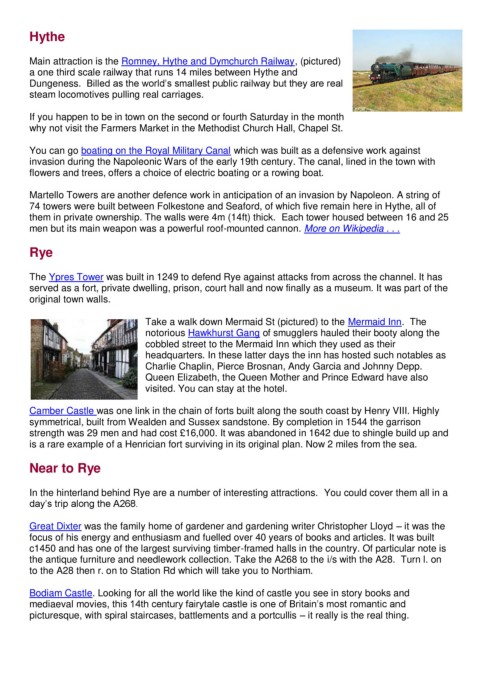Page 48 - demo
P. 48
Hythe
Main attraction is the Romney, Hythe and Dymchurch Railway, (pictured)
a one third scale railway that runs 14 miles between Hythe and
Dungeness. Billed as the world’s smallest public railway but they are real
steam locomotives pulling real carriages.
If you happen to be in town on the second or fourth Saturday in the month
why not visit the Farmers Market in the Methodist Church Hall, Chapel St.
You can go boating on the Royal Military Canal which was built as a defensive work against
invasion during the Napoleonic Wars of the early 19th century. The canal, lined in the town with
flowers and trees, offers a choice of electric boating or a rowing boat.
Martello Towers are another defence work in anticipation of an invasion by Napoleon. A string of
74 towers were built between Folkestone and Seaford, of which five remain here in Hythe, all of
them in private ownership. The walls were 4m (14ft) thick. Each tower housed between 16 and 25
men but its main weapon was a powerful roof-mounted cannon. More on Wikipedia . . .
Rye
The Ypres Tower was built in 1249 to defend Rye against attacks from across the channel. It has
served as a fort, private dwelling, prison, court hall and now finally as a museum. It was part of the
original town walls.
Take a walk down Mermaid St (pictured) to the Mermaid Inn. The
notorious Hawkhurst Gang of smugglers hauled their booty along the
cobbled street to the Mermaid Inn which they used as their
headquarters. In these latter days the inn has hosted such notables as
Charlie Chaplin, Pierce Brosnan, Andy Garcia and Johnny Depp.
Queen Elizabeth, the Queen Mother and Prince Edward have also
visited. You can stay at the hotel.
Camber Castle was one link in the chain of forts built along the south coast by Henry VIII. Highly
symmetrical, built from Wealden and Sussex sandstone. By completion in 1544 the garrison
strength was 29 men and had cost £16,000. It was abandoned in 1642 due to shingle build up and
is a rare example of a Henrician fort surviving in its original plan. Now 2 miles from the sea.
Near to Rye
In the hinterland behind Rye are a number of interesting attractions. You could cover them all in a
day’s trip along the A268.
Great Dixter was the family home of gardener and gardening writer Christopher Lloyd – it was the
focus of his energy and enthusiasm and fuelled over 40 years of books and articles. It was built
c1450 and has one of the largest surviving timber-framed halls in the country. Of particular note is
the antique furniture and needlework collection. Take the A268 to the i/s with the A28. Turn l. on
to the A28 then r. on to Station Rd which will take you to Northiam.
Bodiam Castle. Looking for all the world like the kind of castle you see in story books and
mediaeval movies, this 14th century fairytale castle is one of Britain’s most romantic and
picturesque, with spiral staircases, battlements and a portcullis – it really is the real thing.

